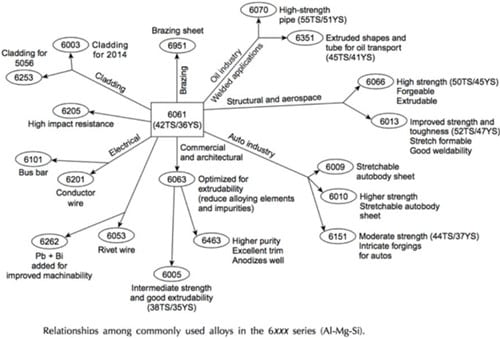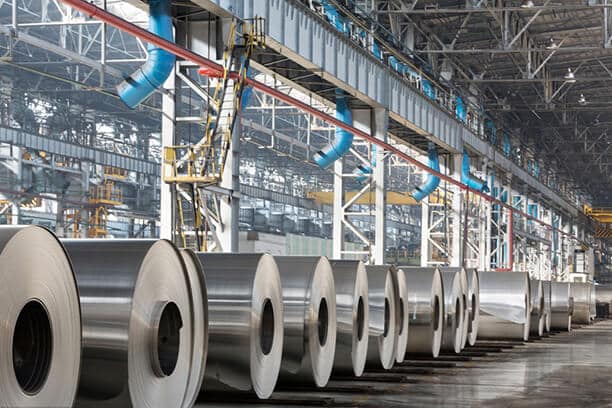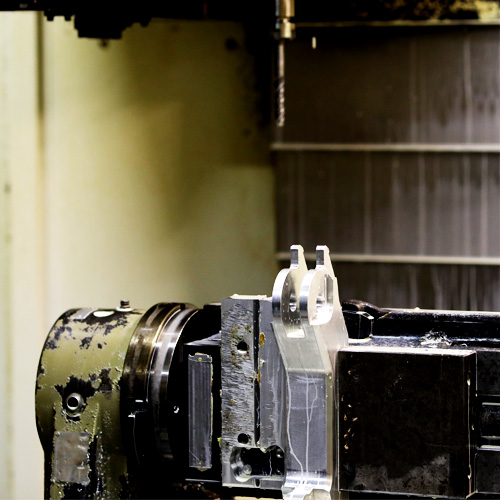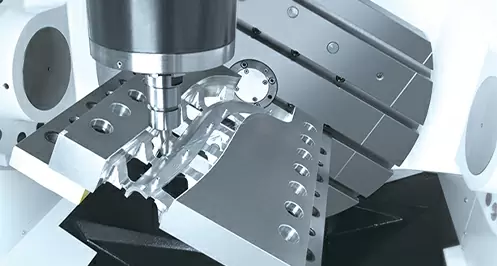Aluminum is a structural material known for its lightweight properties. It can be made even stronger by alloying and subjected to heat treatment or cold working. The temper, in addition to alloying elements, also affects the metal’s properties.
Both aluminum T6 and aluminum T651 are heat-treated aluminum alloys that share common characteristics such as strength, lightweight nature, and corrosion resistance. These properties make them suitable for various applications. However, they have distinct differences, and the choice between the two will depend on the specific application.
To better understand these differences, it’s vital to learn about the aluminum temper designation system. By understanding the different tempers of aluminum alloy, you can thus select the appropriate material for CNC aluminum machining.
Common Temper Designation System for Aluminum Alloys
Aluminum alloys are classified into different temper designations, each representing a specific treatment or process applied to the material. There are five basic temper designations:
- F (as fabricated): it’s used for wrought or cast aluminum products that have undergone a shaping process such as rolling, extrusion, forging, drawing, or casting. The F temper indicates that there was no special control over the thermal conditions or strain-hardening processes during the working of the material. Most F temper products are considered “semifinished” products.
- O (annealed): the O temper is used for wrought or cast aluminum products that have been shaped through drawing, casting, rolling, extrusion, or forging, and at some point in the process have been annealed. Annealing is a heat treatment process that is used to achieve the lowest-strength condition in the material. This temper designation is chosen to maximize subsequent workability or to enhance ductility and toughness.
- H (strain-hardened): it’s used for non-heat-treatable wrought alloys that have undergone a process called strain hardening or work hardening. Strain hardening is a method of increasing the strength of the alloy by subjecting it to plastic deformation, such as cold working.
- W (solution heat-treated): the W temper is limited in its use and only applies to alloys that naturally and spontaneously age after undergoing solution heat treatment. Solution heat treatment involves heating the alloy to a specific temperature and then cooling it rapidly to achieve specific properties. It indicates that the material has been solution heat treated.
- T (thermally treated): used for alloys that have been thermally treated to produce stable tempers other than F, O, or H. When a product is thermally treated, it’s designated with a “-T” temper. The digit after the T indicates the specific thermal treatment applied to the alloy. This can include supplementary treatments with or without strain hardening.
“T” Temper Designations for Aluminum Alloy
The temper designation in aluminum alloys is denoted by a hyphenated suffix added to the basic alloy number, such as the “-T651” in “6061-T651”. The first character, like the “T”, indicates the type of treatment that the alloy has undergone. The digit following the character, along with the capital letter, represents the specific operation type and order.
When it comes to wrought aluminum alloys, they are typically assigned a four-digit number. The first digit in this number identifies the major alloying element used in the alloy as shown in the table below. For casting alloys, the fourth digit is separated from the first three digits by a decimal point and indicates the form of the alloy, whether it’s in the form of casting or ingot. For instance, the 1xxx, 3xxx, 5xxx, and 7xxx series mean forged aluminum alloys, while the 1xx.x, 3xx.x, 5xx.x, and 7xx.x series represent cast aluminum alloys.
In terms of heat treatment, the 1xxx, 3xxx, and 5xxx series are non-heat-treatable alloys, while the 2xxx, 6xxx, and 7xxx series are heat-treatable alloys. The 4xxx series, on the other hand, can contain both heat-treatable and non-heat-treatable alloys.
| 1XXX 997 | Mm. Aluminum |
| 1XX.X 997 | Mm. Aluminum |
| 2XXX | Copper |
| 2XX.X | Copper |
| 3XXX | Manganese |
| 3XX.X | Silicon with added copper and/or magnesium |
| 4XXX | Silicon |
| 4XX.X | Silicon |
| 5XXX | Magnesium |
| 5XX.X | Magnesium |
| 6XXX | Magnesium and silicon |
| 6XX.X | Unused series |
| 7XXX | Zinc |
| SXXX | Other elements |
| 8XX.X | Tin |
| 9XXX | Unused series |
| 9XX.X | Other elements |
Subdivisions of T Temper
Here are the different subdivisions of T temper and their corresponding treatments for aluminum alloys:
- T1: The alloy is cooled from an elevated temperature shaping process and naturally aged to achieve a stable condition.
- T2: This temper is specifically for cast products that have been annealed.
- T3: The alloy is subjected to solution heat treatment and then cold work.
- T4: The alloy undergoes solution heat treatment and is naturally aged to reach a stable condition.
- T5: The alloy is cooled from an elevated temperature shaping process and then artificially aged.
- T6: This is one of the most common temper designations, such as 6061-T6. It involves solution heat treatment followed by artificial aging. Many alloys in the -W and -T4 conditions are artificially aged to achieve the T6 temper. This treatment offers maximum precipitation hardening and therefore maximum yield strength.
- T7: It’s subjected to solution heat treatment and then stabilization.
- T8: It involves solution heat treatment, cold working, and artificial aging.
- T9: The alloy undergoes solution heat treatment, artificial aging, and then cold working.
- T10: The alloy is cooled from an elevated temperature shaping process, artificially aged, and then cold worked.
About Aluminum T6 & Aluminum T651
About Aluminum T6
T6 is a highly sought-after temper for aluminum alloys due to its remarkable strength and exceptional mechanical properties. It’s widely used in various industrial applications. In addition to the alloying elements, the tempering process also plays a significant role in enhancing the properties of the aluminum alloy.
Aluminum T6 Temper
As mentioned before, aluminum alloys mainly have five temper designations. The “T” designation is used for alloys that have undergone thermal treatment. The digit following the “T” represents a specific heat treatment process. In the T6 temper for aluminum, the alloy undergoes a sequence of treatments that starts with solution heat treatment and is followed by artificial aging.
Heat Treatment Process
Firstly, the alloy undergoes a solid solution process by heating it at 525℃ for one hour. This treatment ensures that the alloy becomes fully homogeneous in its solid state, meaning all the alloying elements are uniformly distributed. The alloy is then quenched in water to prevent the formation of precipitates. Consequently, at room temperature, all the alloying elements remain in the solid solution. The rapid quenching is not intentionally performed to strengthen the alloy, but it does contribute to increased strength.
Subsequently, if the alloy is heated within the temperature range of 162-205℃, the alloying elements begin to precipitate and form ordered arrays known as GP zones. These GP zones provide the aluminum alloy with the necessary strength. The heating duration varies depending on the temperature: ranging from 1 hour at 205℃ to 8 hours at 162℃. Despite the different heating rates and temperatures, similar results are typically achieved.
For a clearer understanding of heat treatment in industries, you can refer to the following youtube link:
Mechanical Properties of Aluminum T6
The application of the T6 temper to aluminum results in a significant increase in yield strength, with an approximate fourfold improvement compared to 0-tempered aluminum. For instance, consider the example of 6061 aluminum in the 0-temper condition, which exhibits a yield strength of 55 MPa and a tensile strength of 125 MPa. When this same aluminum alloy is treated with the T6 temper, the yield strength can reach a minimum of 240 MPa, and the tensile strength can exceed 290 MPa.
This substantial increase in strength, combined with its low weight, gives T6-tempered aluminum alloys an advantage over other materials. As a result, they find widespread applications across various industries.
The T6 temper aluminum alloy is highly utilized, primarily due to its high strength-to-weight ratio, weldability, and corrosion resistance. Here are some of its major applications:
- Watercraft: T6 temper aluminum is extensively used in the manufacturing of watercraft due to its outstanding corrosion resistance, making it ideal for marine environments.
- Commercial and military aircraft: The T6 temper aluminum alloy is widely employed in the aerospace industry, both in commercial and military aircraft. Its combination of strength and lightweight properties contributes to improved fuel efficiency and overall performance.
- Bicycle frames: T6 temper aluminum is a popular choice for bicycle frames, as it provides the necessary strength while keeping the weight of the frame relatively low.
- Automotive parts: Various components in the automotive industry benefit from the T6 temper aluminum’s strength and lightweight characteristics. These include engine parts, chassis components, and body panels.
- Fishing reels and firefighter ladders: T6 temper aluminum is also used in the manufacturing of fishing reels due to its corrosion resistance and lightness. Firefighter ladders also often utilize this aluminum alloy for its strength-to-weight ratio.
Pros and Cons of Aluminum T6
Advantages
- The T6 tempering process results in lightweight and high-strength aluminum material.
- It enhances the corrosion resistance of aluminum, making it highly resistant to deterioration caused by various environmental factors. It also exhibits good weldability, allowing for ease of joining or fabrication.
- In comparison to other high-strength aluminum alloys, T6 temper aluminum also demonstrates improved formability, enabling easier shaping and molding. It also exhibits high machinability that enables it to work with various machining techniques or processes.
Disadvantages
- The ideal properties of T6 temper aluminum are achieved through a complex heat treatment process, which necessitates meticulous attention to parameters such as heating rate, duration, and temperature.
- However, due to the intricacies involved in its heat treatment, T6 temper aluminum tends to be more expensive compared to other aluminum grades like T5.
- It’s worth noting that T6 tempering may lead to a reduction in the ductility of the aluminum sample. This means that the material becomes less flexible or malleable.
- Moreover, when working with thicker samples of aluminum, achieving effective heat treatment can present challenges due to uneven cooling during the T6 tempering process. Modifications to the tempering process may be necessary for thicker samples to ensure optimal heat treatment, ultimately saving both time and material.
About Aluminum T651
Aluminum T651 is essentially a subset of the T6 temper, offering improved processability compared to T6 tempered alloys. This makes it particularly useful for machining processes such as grinding, cutting, and polishing. When you need to work with aluminum in these types of machining operations, the T651 temper provides enhanced ease of processing.
Aluminum T651 Temper
The T651 tempering process starts with creating a solid solution. Following this, stress relieving is performed by stretching the material. Finally, artificial aging is done to attain this temper.
Heat Treatment Process
The heat treatment process for achieving the T651 temper differs from the T6 temper. In addition to the steps involved in T6 tempering, T651 tempering includes an extra step known as stress relieving.
After the quenching process, which rapidly cools the alloy, stress relieving is performed to alleviate internal stresses trapped within the material. This is achieved by mechanically stretching the sample, also referred to as cooled stretching, using a specialized stretching machine. This step enhances the dimensional stability of the alloy, allowing it to maintain its shape during subsequent processing and use.
Following stress relieving, the aging process is carried out similarly to the T6 temper. This involves subjecting the material to a controlled heat treatment to encourage the formation of strengthening precipitates within the aluminum.
The incorporation of stress relieving in the T651 tempering enhances the overall properties and dimensional stability of the alloy.
Mechanical Properties of Aluminum T651
The T651 temper of aluminum 6061 maintains its mechanical properties, including elastic modulus, tensile strength, and hardness. This retention of a high strength-to-weight ratio and hardness makes it highly suitable for various processing applications.
During processing, once the external force is removed, internal stresses remain within the material. These internal stresses can cause a recovery effect, resulting in observable changes in size or shape.
The T651 temper is widely utilized in fixed devices, such as mold making, aerospace and electrical components, automobile parts, thick plates, die-forging, and precision machining.
Pros and Cons of Aluminum T651
Advantages
- The T651 temper retains all the excellent properties provided by the T6 temper, including its high strength, corrosion resistance, lightweight nature, and weldability.
- The T651 temper is highly suitable for machining processes as it helps prevent material deformation and enhances dimensional stability after processing.
Disadvantages
- The inclusion of an additional step in the heat treatment process for the T651 temper makes it more costly compared to the T6 temper.
- The presence of an extra step involving controlled stretching in the T651 tempering process results in increased processing time.
Difference Between T6 and T651 Temper
T6: solution treatment + artificial aging. This temper is suitable when there is no need for precise dimensional stability or elastic allowance in the workpiece.
T651: solution treatment + stress-relieve by stretching + artificial aging. It’s recommended for precise workpieces to prevent elastic recovery after processing and ensure dimensional stability.
The T651 temper exhibits superior machinability compared to the T6 temper. It also demonstrates reduced distortion after processing, making it the preferred choice in applications that require complex shapes and high accuracy. However, T651 temper alloys are generally more expensive when compared to T6 temper alloys. The following chart provides a comparison of the properties of these two tempers:
| Material Properties | T6 | T651 |
| Tensile Strength | 310 MPa | 310 MPa |
| Fatigue Strength | 96 MPa | 95 MPa |
| Yield Strength | 276 MPa | 276 MPa |
| Density | 2.7 g/cc | 2.7 g/cc |
| Weldability | Good | Excellent |
| Machinability | Fair | Excellent |
| Corrosion Resistance | Good | Good |
| Elastic Modulus | 69 GPa | 69 GPa |
| Hardness (Brinell) | 93 | 93 |
| Thermal Expansion Coefficient | 24 µm/m-°C | 24 µm/m-°C |
| Thermal Conductivity | 170 W/m-K | 170 W/m-K |
Aluminum 6061 T6 vs T651

The mechanical properties of 6061 aluminum can be altered through different heat treatment methods without changing the alloying elements. Here is a comparison between aluminum 6061 T6 and T651:
Strength
Both aluminum 6061 T6 and T651 have similar tensile strength, around 310 MPa. Likely, they have the same density, resulting in a high strength-to-weight ratio. During the heat treatment process, only stretching is performed, without altering other parameters, contributing to their high strength characteristics.
Heat Treatment
In the T6 temper, the alloy is heated to 980°F for an hour and then quenched in water. This quenching process traps residual stresses inside the sample due to uneven cooling of the core and surface. In contrast, the T651 temper involves stretching the quenched sample by 1 to 3% using a stretching machine to remove these residual stresses.
Dimensional stability
6061 T651 aluminum plates exhibit superior dimensional stability. The absence of internal stresses allows for machining without distorting the final sample. In comparison, the T6 temper offers high strength but is prone to significant distortion during machining processes.
Applications
Due to its excellent dimensional stability and high machinability, T651 is commonly used in sophisticated applications. Both T6 and T651 tempers are widely popular in various industries and have a higher usage rate compared to other aluminum alloys.
| 6061 T6 Aluminum | 6061 T651 Aluminum |
| Bicycle frames | Medical devices |
| Automotive parts | Die forging |
| Aircraft and watercrafts | Precision machining |
| Water pipes and tubes | Robotics and automation |
| Sports industry | Tooling and fixtures |
Aluminum 7075 T6 vs T651

Aluminum 7075-T6
Aluminum 7075-T6 is a grade of 7075 aluminum alloy that has been subjected to the T6 temper. This temper is achieved through a two-step process involving solution treatment and artificial aging. In the solution treatment, the aluminum is heated to approximately 450°C for a specific duration, followed by rapid quenching. The material is then artificially aged at around 120°C for 24 hours, which allows it to reach its desired properties.
7075-T6 aluminum grade exhibits favorable machinability but is not recommended for welding applications. It offers high stability during machining, exceptional stress resistance, and an excellent strength-to-weight ratio. Consequently, this alloy is particularly suitable for structural parts that experience high levels of stress.
Aluminum 7075-T651
This alloy belongs to the 7 series, which consists of aluminum alloys with zinc as the primary alloying element.
Its heat treatment process is similar to that of 6061-T6, wherein the base tempering is T6. This involves solution heat treatment, quenching, and subsequent artificial aging. The strengthening elements during aging are magnesium and zinc-aluminum-copper.
A distinguishing feature of this alloy is the inclusion of the number “5,” indicating that stress is relieved through stretching. Moreover, the number “1” indicates that the amount of stress released through stretching is typically between 0.5% to 2%.
Aluminum 7075 T6 vs T651
Aluminum 7075 T6 and T651 are different grades of the same alloy, sharing a similar alloy composition. However, they undergo different heat treatment processes, resulting in their respective designations as T651 and T6.
These grades exhibit different mechanical properties due to their distinct processing methods. For instance, the T651 temper generally offers slightly higher yield and tensile strength compared to the T6 temper in 7075 aluminum material. Conversely, T651 may have a lower percentage of elongation when compared to the T6 alloy.
Aluminum 6061-T6 vs 7075-T6
What’s the difference between aluminum 7075-T6 and 6061-T6? The following two charts include the physical properties, mechanical properties, and chemical composition of 6061-T6 and 7075-T6 aluminum.
Comparison of Aluminum 6061-T6 and 7075-T6 Composition
| Elements | Aluminum 6061-T6 | Aluminum 7075-T6 |
| Aluminum (AI, %) | 95.9-98.6 | 86.9-91.4 |
| Chromium (Cr, %) | 0.04-0.35 | 0.18-0.28 |
| Copper (Cu, %) | 0.15-0.4 | 1.2-2.0 |
| lron (Fe, %) | 0-0.7 | 0-0.5 |
| Magnesium (Mg, %) | 0.8-1.2 | 2.1-2.9 |
| Manganese (Mn, %) | 0-0.15 | 0-0.3 |
| Silicon (Si, %) | 0.4-0.8 | 0-0.4 |
| Titanium (Ti, %) | 0-0.15 | 0-0.2 |
| Zinc (Zn, %) | 0-0.25 | 5.1-6.1 |
| Zirconium (Zr, %) | 0 | 0-0.25 |
| Residuals (%) | 0-0.15 | 0-0.15 |
Comparison of Aluminum 6061-T6 and 7075-T6 Properties
| Properties | Aluminum 6061-T6 | Aluminum 7075-T6 |
| Density (g/cm3) | 2.7 | 3.0 |
| Melting Onset (C) | 580 | 480 |
| Melting Completion (C) | 650 | 640 |
| Thermal Conductivity (W/m-K) | 170 | 130 |
| Ultimate Tensile Strength (MPa) | 310 | 560 |
| Yield Tensile Strength (MPa) | 270 | 480 |
| Brinell Hardness | 93 | 150 |
| Elongation at Break (%) | 10 | 7.9 |
| Fatigue Strength (MPa) | 96 | 160 |
| Shear Strength (MPa) | 210 | 330 |
Aluminum 6061-T6 vs 7075-T651
Both Aluminum 6061-T6 and 7075-T651 are heat-treated aluminum alloys with similar properties. They are both strong and machinable. However, there are notable differences between them.
Aluminum 7075-T651 exhibits higher tensile strength and yield strength compared to aluminum 6061-T6. This indicates greater resistance to deformation. On the other hand, aluminum 6061-T6 is more ductile, making it more resistant to cracking and easier to machine.
How to Choose Between T6 and T651
T6
The T6 temper is suitable for the following requirements:
- When a high strength-to-weight ratio is required, the T6 temper provides sufficient hardness and strength, making it suitable for heavy load-bearing applications.
- When machining processes for part fabrication are relatively simple and require fewer steps and less processing time, the T6 temper is preferred.
- If budget is a crucial factor in the decision-making process, the T6 temper is typically more cost-effective compared to T651.
T651
T651 temper is commonly preferred in the following industries or applications:
- When there is a need to enhance the machinability of aluminum alloys, T651 tempering is employed through controlled stretching.
- In applications that necessitate high dimensional stability after machining processes, T651 tempering is the recommended process. This tempering process removes internal stresses, resulting in minimal distortions. It’s particularly suitable for industries such as automation and robotics.
- The controlled stretching involved in T651 tempering also improves the weldability of the aluminum alloy. Therefore, in cases where superior welding performance is required, T651 tempering is utilized.
Conclusion
A slight variation in the heat treatment process has resulted in significant improvements in key mechanical properties. Both alloys, Al7075-T651 and Al7075-T6, undergo solid solution treatments and age-hardening processes. However, in the T651 temper, stretching is also performed before quenching, which greatly enhances machinability and formability.
Considering these differences, the selection of either alloy depends on the desired properties. T651 is superior in terms of welding, machinability, and dimensional stability. However, it involves a more complex heat treatment process and is comparatively more expensive. If there is no compromise on these properties, T651 should be chosen. However, if some compromise can be made on these properties to save cost, the less expensive T6 alloy can be used. T651 is an excellent choice for fabricating thick plates, milling, and die forging. If fair machinability and formability are sufficient, the readily available and less costly T6 temper is recommended.
Expert for CNC Machined Aluminum Parts — Runsom Precision
CNC machined aluminum parts are commonly applied in various industries such as machinery, industrial equipment, automotive, and aerospace. T651 temper is commonly preferred for machining these parts due to its desired mechanical properties. If you are looking for CNC machining services, Runsom Precision may be your premier choice. The engineers at Runsom Precision can guide you in selecting the optimal manufacturing process for different materials based on specific application requirements. Request an instant quote now to get high-quality CNC machined aluminum parts now!
Other Articles You May Be Interested in:





